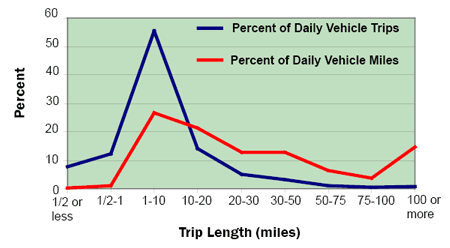The vast majority of US auto trips are under 100 miles. We drive to the supermarket, nearby restaurant or hardware store; we head to and from work for our commute; and then we have those occasional 100-mile trips to the beach, wine country or grandma’s house.

An EV with 150 miles of range can comfortably handle these trips. But we are irrational consumers and buy our cars for the 2-3 longer trips of 250 miles or longer we might take each year to the mountains, mom and dad’s house or Disneyland/Disneyworld.
This is why EVs with ranges of around 250 miles or more are so important to mass adoption. The Bolt with its 238 miles of range has the longest range among EVs other than Tesla’s with 75 kWh or greater battery pack.
But unlike Tesla, GM has not built out a fast-charging network nor invested in a strategic charging partner to build out a network. One sales representative at a local Chevrolet dealer in fact told me: “GM would not invest in charging infrastructure, but rely on networks such as Chargepoint.”
GM spokesperson Fred Ligouri basically confirmed this with this response to my question: What are the plans, if any, for partnering or building out fast charging networks?: “In the case of L3 chargers, the number of CCS-compatible chargers has grown more than 300% in the past year and continues to grow rapidly.”
Nowhere in his response did he mention GM investing in charging networks, of any type. I get that GM doesn’t want to invest when they are hoping the marketplace does it for them. But, and this is a big but, the lack of reliable fast chargers along key interstates and destinations are a huge disadvantage when compared to Tesla’s Supercharger and Destination Charger networks.
The inconvenience resulting from GM’s lack of fast charging availability was chronicled by a Northern California Bolt owner and highlighted the gap in GM’s strategy.
And while Tesla promises up to 170 miles of charge in 30 minutes when charging via a Tesla Supercharger, Chevrolet promotes about half that, 90 miles of charge in 30 minutes via DC fast charging at unnamed “… participating locations.” And BTW, DC fast charging capability will set you back an additional $750.

Fixes: Invest in destination charging networks. GM should work with its charging network partner Chargepoint (and other networks) to build out destination chargers at hotels, restaurants and other locations along major highways and destinations in California first, followed by the other top EV markets. GM should partner with national restaurant and hotel chains that already have locations in key EV destination markets and embark on joint marketing programs.
Start with the state that buys 50% of electric cars and make sure that Level 2 and DC fast chargers are at key destinations and enable common road trips such as along major north/south highways 1, 5 and 101.
Take a page out of the restaurant industry location strategy which was to piggyback off of McDonalds and locate your fast food restaurant on the opposite corner. The theory was that the McDonald’s corporate real estate group was the best in the business so if they located a restaurant in a specific spot, it was a safe bet to put your fast-food restaurant nearby.
GM should look at the Tesla destination and Supercharger locations and work with Chargepoint and destination businesses to ensure they have adequate charging at or near the same locations. After nailing California, they can knock off other states with the highest percentage of Bolt and other EV sales. GM can also likely leverage data it has from where Volt drivers already charge and market to owners and prospects of the Volt, Bolt and Spark models.
Of course, the executives at GM were likely salivating at the prospect of benefitting from Volkswagen’s Electrify America $2 billion diesel cheating settlement in the US. The Electrify America initiative includes building out 500+ Level 2 charging stations and DC fast charging stations, including a high percentage located in California and a cross-country network.
But while the GM board is likely not excited about investing in a charging network, they need to prove to buyers of the Bolt EV that they are actually committed to a future of EVs and make a stronger commitment to building out charging networks. Simply relying on the market and others to supply the EV charging infrastructure might be cost-effective, but this approach is also going to limit sales of the Bolt.
The range/fast-charging issue is a bit of chicken and egg situation. Without a fair number of non-Tesla long-range EVs available to buy, few companies are going to want to invest in chargers along major interstate locations. But without these chargers, then buyers of EVs with 200+ miles of range cannot conveniently take advantage of the extra range that they’ve paid for. And that is a problem for current and potential buyers of the Bolt.
Next mistake in this series on the Bolt is: The Price Is Too High.
 Announcing the acquisition of EVAdoption by Paren →
Announcing the acquisition of EVAdoption by Paren →
One Response